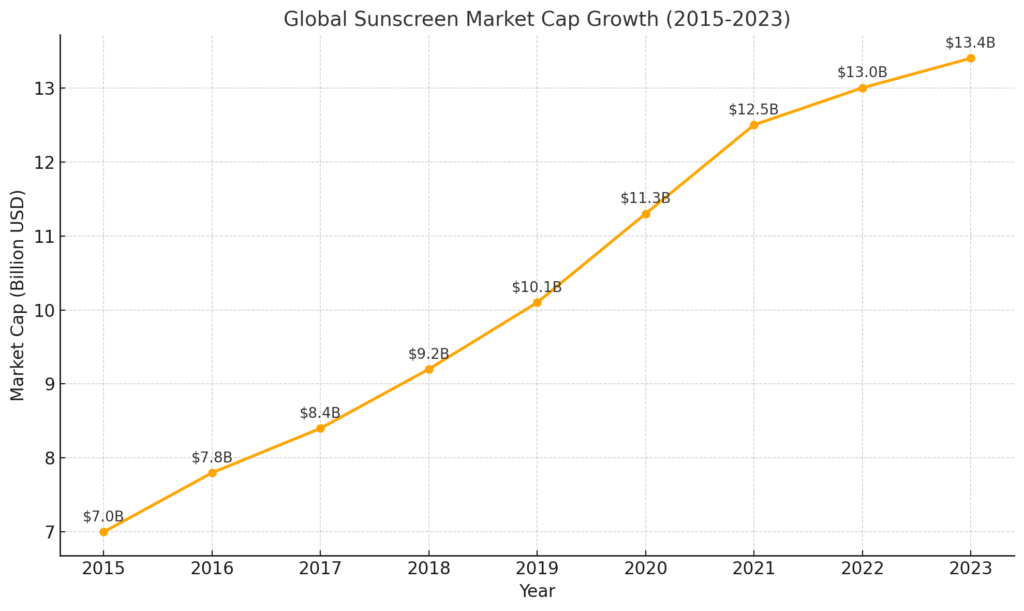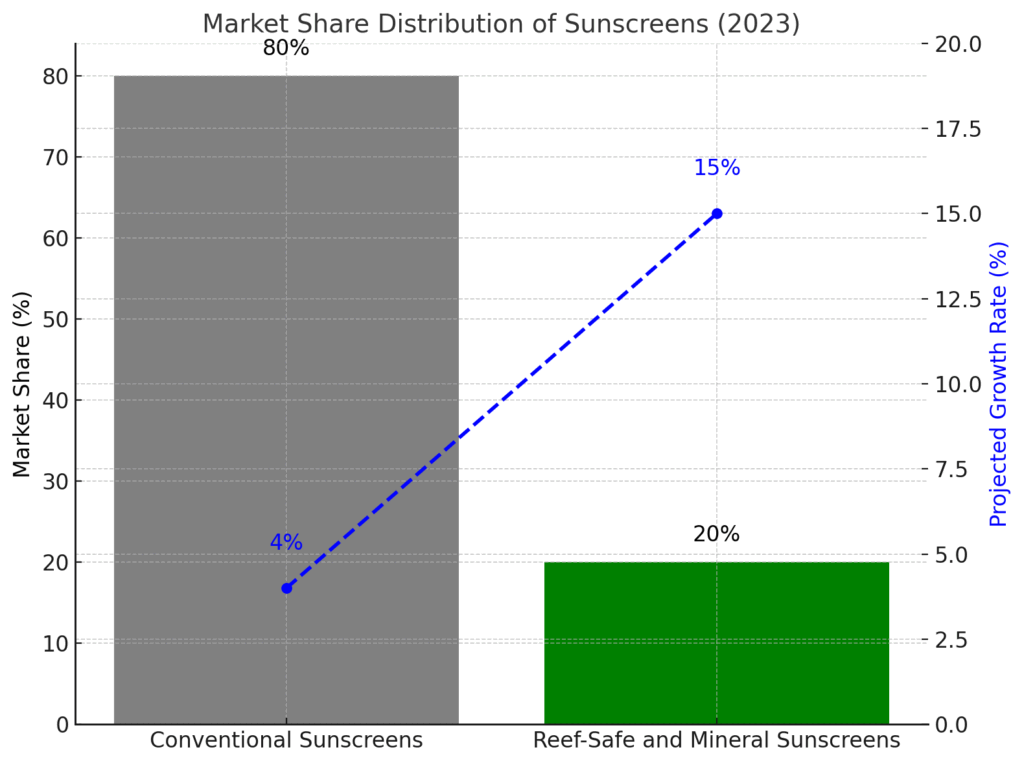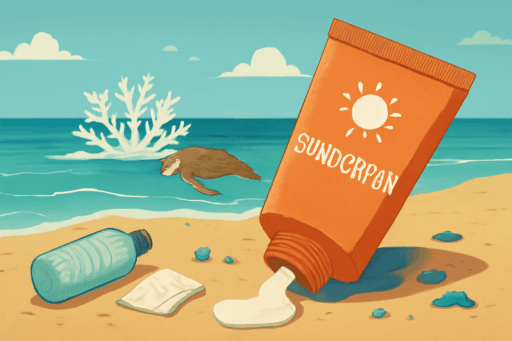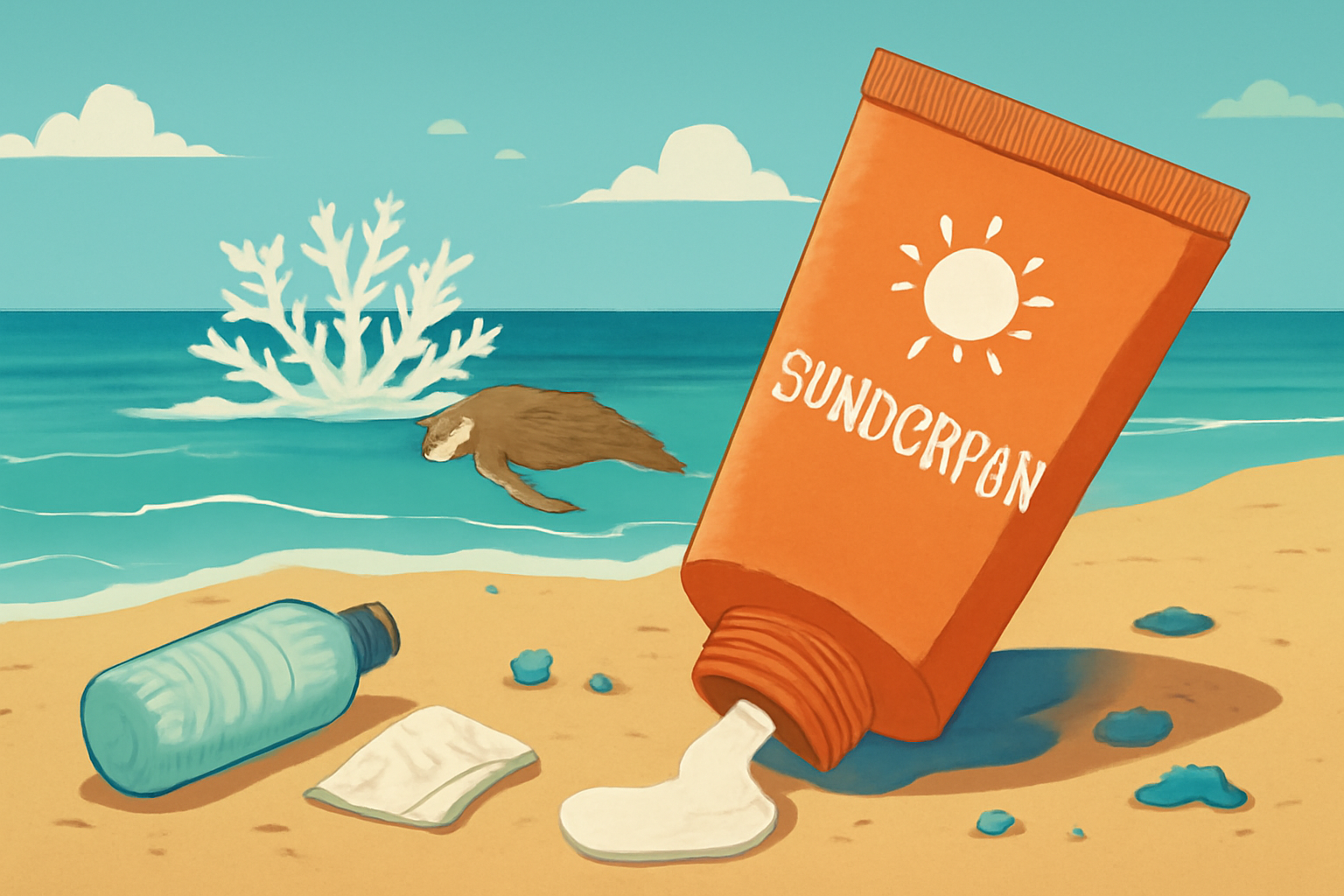Sunscreen products are marketed as a necessary shield against harmful UV radiation, offering protection against skin cancer, premature aging, and pigmentation. However, these products come with hidden costs, particularly when considering their environmental impact, health risks, and long-term sustainability. As the global sunscreen market continues to grow—valued at $13.4 billion in 2023 and projected to expand at a 6.4% CAGR—it becomes increasingly important to address the unsustainable practices surrounding the ingredients, packaging, and environmental consequences of these products.
The sunscreen industry’s success in improving skin protection should be matched by efforts to mitigate its broader effects on human health, the environment, and the circular economy. In this section, we explore the current sustainability challenges of sunscreens, the emerging alternatives, and the opportunity for a market shift toward greener, safer products.

Here is the chart illustrating the global sunscreen market cap growth from 2015 to 2023. The market cap has steadily increased from approximately $7.8 billion in 2015 to $13.4 billion in 2023, highlighting the significant expansion of the industry. This growth indicates a rising demand for sunscreen products, even as the market begins to shift towards more sustainable and eco-friendly alternatives.
The Environmental Impact of Sunscreens
Sunscreens contain chemical ingredients like oxybenzone, avobenzone, and octinoxate, which have been shown to harm marine life, especially coral reefs. The sunscreen industry’s use of synthetic chemicals and non-recyclable packaging exacerbates environmental degradation, making it a significant contributor to ocean pollution and landfills.
Key Environmental Challenges
- Coral Bleaching and Reef Damage: Ingredients like oxybenzone and octinoxate have been identified as major contributors to coral bleaching. Studies show that these chemicals can trigger coral mortality, inhibit coral growth, and cause irreversible damage to ecosystems.
- Over 14,000 tons of sunscreen enter coral reef ecosystems annually, posing a direct threat to biodiversity (source: World Health Organization).
- 10% of the world’s coral reefs are endangered due to the presence of harmful sunscreen chemicals (source: National Park Service).
- Water Pollution: Sunscreens are washed off into the water during swimming or bathing, with their chemical compounds polluting rivers, lakes, and oceans. These chemicals accumulate in aquatic life, causing ecosystem imbalances and impacting the quality of water resources.
- Plastic Waste: Sunscreen packaging, predominantly made from plastic, contributes to global waste. Many sunscreen bottles are non-recyclable or hard to reuse, adding to the growing global waste crisis.
Health Risks from Sunscreens
While sunscreens provide vital protection against UV rays, certain chemical ingredients in conventional products have been linked to hormone disruption and skin irritation. The absorption of sunscreen ingredients into the skin has raised alarms about their potential to cause systemic health issues, especially when used repeatedly.
Key Health Concerns
- Hormone Disruption: Chemicals like oxybenzone can interfere with hormone levels, leading to adverse reproductive and developmental effects. Research has found that oxybenzone can enter the bloodstream and accumulate in urine, blood, and even breast milk (source: Environmental Working Group).
- The FDA’s 2019 study found that sunscreen chemicals reach dangerous levels in the bloodstream after just one application (source: FDA).
- Over 80% of sunscreens contain oxybenzone or other endocrine-disrupting chemicals, despite the growing body of evidence pointing to their harmful effects.
- Skin Sensitivity: Sunscreens containing synthetic fragrances, parabens, and other artificial chemicals can cause skin irritation, allergic reactions, or exacerbate existing skin conditions, particularly for those with sensitive skin or preexisting dermatological conditions.
- Nanoparticle Risks: Some sunscreens contain nanoparticles of zinc oxide or titanium dioxide, which can penetrate deeper layers of the skin. The long-term effects of these nanoparticles on human health are not fully understood, and they may have unanticipated consequences on skin health.

Here is a chart displaying the market share distribution of conventional sunscreens versus reef-safe and mineral sunscreens in 2023. The blue dashed line shows the projected growth rate for both segments, with reef-safe and mineral sunscreens expected to grow significantly faster, at a rate of 15% CAGR compared to 4% CAGR for conventional sunscreens. This highlights the rising consumer demand for sustainable alternatives and the market opportunity for greener products.
Why People Still Use Sunscreens
Despite the growing evidence of their environmental and health impacts, sunscreens continue to be a widely used product, driven by various factors:
- Health and Beauty Industry Influence: The sunscreen market is bolstered by the health and beauty industry, which promotes sunscreens as essential tools for skincare, anti-aging, and UV protection. The industry, valued at $49.6 billion in 2023, continues to profit from public perceptions of sunscreen as a necessity (source: Statista).
- Consumer Trust: Many consumers trust sunscreen products due to their extensive marketing and endorsements by dermatologists. As a result, consumers often overlook the potential dangers of chemicals in sunscreens.
- Convenience and Affordability: Chemical sunscreens are easy to apply and readily available. This convenience, combined with relatively low prices, makes them an attractive option for the mass market, despite the hidden health and environmental consequences.
- Lack of Awareness: There is still limited awareness regarding the environmental and health impacts of sunscreens, especially in developing countries. As such, demand for eco-friendly alternatives is not yet widespread.
How Sunscreens Can Become More Sustainable
There is a growing demand for more sustainable and healthier sunscreen options. Brands have a unique opportunity to reformulate their products, embrace eco-friendly packaging, and invest in clean, non-toxic ingredients that support both human and environmental health.
Strategies for a Sustainable Sunscreen Industry
- Eco-Friendly Packaging: Sunscreen brands can reduce their environmental footprint by switching to recyclable or biodegradable packaging. This helps minimize waste and supports the transition to a circular economy.
- Chemical-Free Formulations: Developing sunscreens without harmful chemicals such as oxybenzone, octinoxate, and parabens can help reduce the product’s negative environmental and health impacts. Mineral sunscreens made from non-nano zinc oxide or titanium dioxide are a promising alternative.
- Reef-Safe and Natural Ingredients: The growing popularity of reef-safe sunscreens signals a shift toward using natural ingredients that do not harm marine ecosystems. Companies should further invest in developing these formulas to protect marine biodiversity.
- Sustainable Production Methods: Sustainable production processes, including sourcing raw materials ethically and using renewable energy in manufacturing, can further enhance the sustainability of sunscreen products.
Alternatives to Traditional Sunscreens
Several innovative and sustainable alternatives to conventional chemical sunscreens are already gaining traction in the market. These alternatives offer a healthier choice for consumers while minimizing the environmental impact of the products.
- Mineral Sunscreens: These use natural minerals like zinc oxide and titanium dioxide to create a physical barrier against UV radiation. Unlike chemical sunscreens, mineral sunscreens do not get absorbed into the skin, making them safer for both humans and the environment.
- Natural Oils: Certain plant-based oils like coconut oil, raspberry seed oil, and carrot seed oil offer some UV protection. While they don’t replace sunscreens for full-spectrum protection, they serve as safer, more natural alternatives for those seeking lower levels of protection.
- Clothing and Shade: Protective clothing, hats, and seeking shade remain the most natural way to avoid sun exposure without chemicals. These methods reduce the need for sunscreen and can be integrated into sustainable lifestyle choices.
- Reef-Safe and Non-Toxic Sunscreens: More companies are developing reef-safe sunscreens that avoid harmful chemicals and use biodegradable ingredients. These products are safe for both skin and the marine environment, providing an ethical and effective alternative.
Market Opportunity for Sustainability in Sunscreens
The shift toward sustainable, eco-friendly sunscreens represents a significant market opportunity. As consumer awareness grows, brands that prioritize safety and sustainability will gain a competitive advantage.
Market Statistics and Growth Potential
- Natural and Organic Personal Care Products: The global market for natural personal care products is projected to reach $25 billion by 2025 (source: Grand View Research), fueled by demand for sustainable and health-conscious alternatives.
- Consumer Trends: A study by Nielsen revealed that 66% of global consumers are willing to pay more for sustainable products, indicating strong potential for growth in the eco-friendly sunscreen market (source: Nielsen).
- Rising Popularity of Reef-Safe Sunscreens: According to recent reports, sales of reef-safe sunscreens have increased by 27% annually in the U.S. as awareness grows about the environmental impact of traditional sunscreens (source: Environmental Working Group).
Market Share Distribution: Conventional vs. Eco-Friendly Sunscreens
| Market Segment | Share (2023) | Projected Growth (2025) |
|---|---|---|
| Conventional Sunscreens | 80% | 4% CAGR |
| Reef-Safe and Mineral Sunscreens | 20% | 15% CAGR |
Source: Grand View Research, Environmental Working Group
The sunscreen industry, though essential for sun protection, faces significant sustainability challenges. Chemical ingredients in sunscreens harm marine life, pollute ecosystems, and may pose health risks to consumers. While the market for sunscreen products continues to grow, the opportunity for positive change is clear. By reformulating sunscreens with safer ingredients, adopting eco-friendly packaging, and focusing on consumer education, the industry can contribute to both human and environmental well-being.
The rising demand for natural, eco-conscious alternatives presents an opportunity for brands to capitalize on the growing market for sustainable products. This shift is not only a moral imperative but also a market-driven opportunity that aligns with evolving consumer preferences for cleaner, greener, and more ethical products. The future of sunscreen lies in embracing innovation, sustainability, and transparency, ensuring that the products we use to protect our skin no longer harm the planet.
Sources
Grand View Research, “Sunscreen Market Size, Share & Trends Analysis Report By Product Type, By Application, By Region, And Segment Forecasts, 2023 – 2030”, 2023.
National Park Service, “Sunscreen and Coral Reefs”, https://www.nps.gov/subjects/oceans/sunscreen-and-corals.htm
World Health Organization, “Sun Protection and Its Impact on Marine Ecosystems”, https://www.who.int/news-room/fact-sheets/detail/sun-protection
NOAA (National Oceanic and Atmospheric Administration), “Coral Reefs and the Impact of Sunscreens”, https://oceanservice.noaa.gov/facts/coral-reefs-and-sunscreens.html
Environmental Working Group (EWG), “Sunscreen Chemicals and Their Impact on Health and the Environment”, https://www.ewg.org/sunscreen
U.S. Food and Drug Administration, “Sunscreen Absorption Study 2019”, https://www.fda.gov/news-events/press-announcements/fda-announces-steps-strengthen-regulation-sunscreens
Statista, “Health and Beauty Industry Market Size 2023”, https://www.statista.com/statistics/490000/global-market-size-health-beauty-industry/
Grand View Research, “Natural and Organic Personal Care Products Market Size”, https://www.grandviewresearch.com/industry-analysis/natural-organic-personal-care-products-market
Nielsen, “Consumer Preferences and Willingness to Pay More for Sustainable Products”, https://www.nielsen.com/us/en/insights/article/2020/how-sustainability-is-changing-consumers-buying-habits/
Environmental Working Group (EWG), “The Growth of Reef-Safe Sunscreens”, https://www.ewg.org/sunscreen-guide






